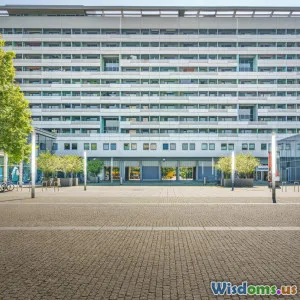
Top Three Factors Driving Commercial Real Estate Growth
10 min read Explore the top three crucial factors fueling commercial real estate growth in today’s rapidly evolving market landscape. (0 Reviews)
Top Three Factors Driving Commercial Real Estate Growth
The skyline of every bustling city tells a story of economic ambition, evolving business needs, and shifts in society. But when you look deeper into the fabric of commercial real estate, you quickly realize growth doesn’t happen by accident—it’s the result of diverse, powerful forces converging. Business leaders, property investors, and city planners are constantly assessing these factors to determine where the next opportunity lies. Here we’ll unpack the three most significant drivers fueling today’s commercial real estate (CRE) expansion and learn how you can harness these trends to your advantage.
Demographic Shifts and Urbanization Trends

Demographics aren’t just statistics; they shape the futures of neighborhoods, cities, and entire regions. One of the most potent drivers of CRE growth is the shift in where—and how—people live and work.
The Urban Renaissance
In the past decade, urbanization has accelerated worldwide. According to United Nations data, more than 55% of the world’s population now lives in urban areas, a figure expected to reach 68% by 2050. The U.S. reflects this trend: cities such as Austin, Nashville, and Charlotte have seen explosive population growth as millennials and Gen Z flock to urban job markets and amenities.
Concrete Example: Austin, Texas, added over 579,000 residents from 2010 to 2020, pushing office, retail, and mixed-use space demand skyward. The downtown district has seen a building boom—with 36 new towers under construction as of late 2023, dedicated to office, residential, and hospitality uses.
Young Professionals and New Lifestyles
Younger generations increasingly value walkability, coworking spaces, and live-work-play communities. As the workforce becomes more mobile, companies seek modern office buildings with amenities that attract top talent. The demand for properties like WeWork’s flexible workspaces in major cities exemplifies this: in 2019 alone, WeWork doubled its presence, leasing over 11.5 million square feet of office space globally.
Population Movement and Suburban Revival
Interestingly, the pandemic induced a short-term shift—many urban dwellers moved to suburban locales seeking more space and affordability. In turn, suburban commercial space became attractive for corporate campuses and logistics hubs. Amazon, for instance, expanded over 100 new distribution centers, many in suburban and peri-urban districts, between 2020 and 2022 to serve rising e-commerce needs.
Actionable Insight: Analyze local demographic data before investing. Rapid population growth, shifting age groups, or diversification of a city can predict strong demand for specific CRE types—be it logistics, multifamily, or retail.
Technological Innovations Reshaping the Built Environment

Technology isn’t just influencing how properties are marketed—it’s fundamentally redefining commercial real estate, from amenities to operations and tenant expectations.
Smart Buildings and Proptech Evolution
The rise of property technology (proptech) is revolutionizing every stage of CRE. Advanced building management systems now enable remote temperature, lighting, and security control. According to JLL, global proptech investment reached $18.2 billion in 2023—a 23% increase from the prior year.
One striking example is The Edge in Amsterdam, often called “the smartest building in the world.” It employs 28,000 sensors to monitor everything from occupancy to air quality and readjust resources for maximum efficiency, reducing operational costs by as much as 70%..
E-commerce and Logistics Space Boom
E-commerce necessitates vast logistics and distribution footprints. As digital sales leapfrog, industrial real estate becomes red-hot. CBRE reported in early 2024 that e-commerce occupied 35% of all new U.S. industrial leasing—a tenfold increase since 2010.
Amazon and Walmart are some of the largest private occupiers of U.S. industrial space, often customizing facilities with robotics and AI for streamlined order fulfillment. Drone delivery and automated last-mile centers are on the near horizon, intensifying the race for proximate, tech-ready warehouses.
The Rise of Flexible Workspaces
Post-pandemic, hybrid work models demanded flexible, tech-equipped office spaces. Companies now prioritize digital connectivity, air purification, and shared amenities. Platforms like Industrious and Convene offer on-demand conference facilities and enterprise-grade networking.
How-To-Tip: Investing in digital infrastructure—fiber connectivity, automation systems, and smart monitoring—enhances asset value in today’s competitive CRE market. Upgrading older properties often yields higher occupancy rates and increased rents.
Economic Climate and Capital Markets Activity

No analysis of commercial real estate would be complete without considering the macroeconomic and financial currents driving it. The interplay of investment, interest rates, and regulatory frameworks can accelerate or dampen CRE growth cycles.
Low Interest Rates and Accessible Capital
In the wake of the 2008 financial crisis and again during the early COVID-19 years, central banks kept interest rates at record lows. This fueled record inflows into CRE, as traditional safe havens like bonds yielded less return. According to Nareit, global real estate investment volume hit $875 billion in 2022—a historic high—thanks largely to low-finance costs.
Case Study: Blackstone, the private equity giant, has grown its global real estate assets under management to over $332 billion as of Q4 2023, strategically leveraging inexpensive capital to acquire logistics and multifamily properties worldwide.
Foreign Investment and Cross-Border Flows
International capital has become a pivotal force. Middle Eastern wealth funds, Canadian pension funds, and Asian REITs have snapped up trophy assets in New York, London, Paris, and Sydney.
In 2023, the U.S. alone received $38.4 billion in inbound cross-border CRE investment, according to MSCI Real Assets, with overseas buyers eager to acquire premier office, hotel, and industrial assets in economically stable regions.
Shifting Regulatory and Policy Landscape
Finally, tax incentives and zoning liberalization spur development booms. For example, the U.S 2017 Tax Cuts and Jobs Act enabled Opportunity Zones—low-income tracts that benefit from capital gains tax deferrals on property investments. Hundreds of billions in new deals flooded these zones, revitalizing neglected neighborhoods in cities like Detroit, Cleveland, and Baltimore.
Analysis Tip: When assessing a market, watch not only national policy but city- or state-level incentives—special economic zones, upzoning, and infrastructure outlays can deliver outsize returns in certain locales.
Putting the Drivers to Work for Your Portfolio

Growth in commercial real estate isn’t the product of a single trend, but rather the convergence of demographic change, rapid innovation, and adaptable capital. Investors and developers who recognize how these drivers interconnect—such as leveraging demographic movement data to identify up-and-coming tech corridors, or factoring in how new tax incentives may make a project viable—are best positioned for success.
For new entrants, consider partnering with local brokerage experts, subscribing to detailed demographic and property analytics, and attending emerging technology workshops. For seasoned investors, periodic portfolio reviews that account for shifts in all three driver categories—population, technology, and financial environment—can help outperform a static, reactive approach.
The skylines of tomorrow are being shaped today. Whether investing, developing, or just seeking to understand the winsome world of CRE, focus on these driving forces. The greatest opportunities come not just from knowing the trends, but from anticipating their intersections and being agile in your real estate strategy.
Rate the Post
User Reviews
Popular Posts


















